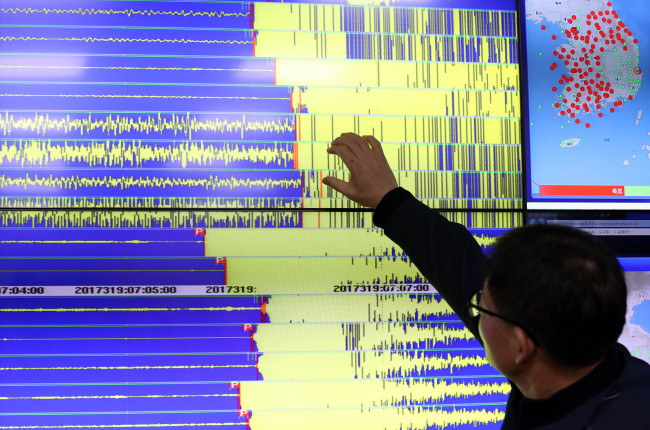South Korean earthquake experts warned that more aftershocks and even bigger quakes may occur for the next few months following Wednesday’s 5.4 magnitude quake in Pohang, North Gyeongsang Province.

Wednesday’s quake took place at 2:29 p.m. At least 62 people were hurt, but no casualties were reported, according to authorities.
The quake comes 14 months after a 5.8 magnitute quake hit Gyeongju, the strongest since the country began to collate seismic records in 1978.
Experts voiced concerns that the Korean Peninsula is no longer safe from strong shock waves, adding that powerful aftershocks may follow for months.
“When magnitude 5 or more powerful earthquakes occur, large and small aftershocks usually continue for months,” Kim So-gu, head of Korea Earthquake Research Center, told the Korea Herald, citing the precedent here.
“Last September, Gyeongju was struck with a bigger quake a week after a slightly less powerful 5.1 magnitude quake hit the region. The latest quake may be a prelude to larger-scale tremors to occur in the coming days,” he said.
As of 5 p.m. Thursday, the Pohang area had experienced 45 small-scale aftershocks with magnitudes ranging between 2 and 3.6.
The Korea Meteorological Administration said the quake may have been triggered by ruptures in the Yangsan fault plane.
“Although we need further analysis on the activities of the Yangsan fault plane, we assume that the latest quake was caused by the displacement of a fault active in the country’s southeastern region,” Lee Mi-sun, head of seismic and volcanic affairs at the KMA, told reporters during a press briefing Thursday.
“We are also assessing the link to the Gyeongju quake, since the epicenter of Wednesday’s quake in Pohang was just 43 kilometers away from Gyeongju.”
An expert suggested that it is too early to assume that the Yangsan fault plane was the direct cause of Wednesday’s quake, raising the possibility that there may be unknown fault lines.
“There are not many known active faults below the Pohang area, and there should be more research into unknown active fault lines around that area,” Hong Tae-kyung, a professor of earth science at Yonsei University, told the Korea Herald.
The Yangsan fault plane is the most prominent fault plane in the southeastern part of the Korean Peninsula.
Other experts called for the government’s prompt measures to prevent disasters.
“The government needs to prepare for the possibility of a quake of 7 magnitude or higher, as well as bolster efforts to have more quake-resistant buildings and facilities around people,” said Kim Kwang-hee, a professor of geography and environment science at Pusan National University, in an interview with a Korean daily.
The lack of earthquake-proof facilities and measures across the nation is also problematic, he said, adding that Korea needs to step up efforts in case of any possible quakes.
According to Ministry of Land, Infrastructure and Transport data, in 2015, just 26.7 percent of buildings that are at least three stories high or over 13 meters in Seoul were built based on earthquake-proof designs. The total figure across the country was slightly above 34 percent.
By Kim Da-sol (ddd@heraldcorp.com)





![[From the Scene] Monks, Buddhists hail return of remains of Buddhas](http://res.heraldm.com/phpwas/restmb_idxmake.php?idx=644&simg=/content/image/2024/04/19/20240419050617_0.jpg&u=20240419175937)





![[Graphic News] French bulldog most popular breed in US, Maltese most popular in Korea](http://res.heraldm.com/phpwas/restmb_idxmake.php?idx=644&simg=/content/image/2024/04/18/20240418050864_0.gif&u=)



![[From the Scene] Monks, Buddhists hail return of remains of Buddhas](http://res.heraldm.com/phpwas/restmb_idxmake.php?idx=652&simg=/content/image/2024/04/19/20240419050617_0.jpg&u=20240419175937)

![[KH Explains] Hyundai's full hybrid edge to pay off amid slow transition to pure EVs](http://res.heraldm.com/phpwas/restmb_idxmake.php?idx=652&simg=/content/image/2024/04/18/20240418050645_0.jpg&u=20240419100350)

![[Today’s K-pop] Illit drops debut single remix](http://res.heraldm.com/phpwas/restmb_idxmake.php?idx=642&simg=/content/image/2024/04/19/20240419050612_0.jpg&u=)